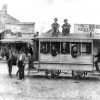calsfoundation@cals.org
Arkansas and Oklahoma Western Railroad
The Arkansas and Oklahoma Western Railroad (A&OW), based in Rogers (Benton County), was incorporated on June 25, 1907, with capital stock of $3,000,000. The standard gauge railroad, previously named the Rogers Southwestern, had twenty-one miles of track built between Rogers and Springtown (Benton County) by the Rogers Southwestern Railroad. The change in the corporate name reflected an intention to build to Siloam Springs (Benton County), as a connection to the Kansas City Southern Railway, and Pryor Creek, Oklahoma, as a connection to the Missouri, Kansas and Texas Railway. The A&OW also announced plans for a thirty-mile extension from Rogers to the health resort of Eureka Springs (Carroll County). The A&OW, assuming it had been built as planned, would have been 125 miles long. Rogers banker William R. Felker was the principal financial backer of the Rogers Southwestern and successor A&OW.
The Panic of 1907, a national recession, probably delayed the sale of bonds to finance the railroad’s ambitious expansion plans. The nine-mile gap between Springtown and Siloam Springs was in service by October 1907, thus completing a rail route between Rogers and Siloam Springs. Because the railroad served an apple-growing district located between Lowell (Benton County) and Highfill (Benton County), the railroad called itself “The Fruit Belt Line.” In the summer of 1910, the A&OW completed a one-and-a-half-mile extension that linked the Monte Ne Railroad to the A&OW at Homewood in southern Rogers. The extension shifted Monte Ne Railroad freight and passenger traffic to the A&OW rather than the St. Louis–San Francisco Railway, better known as the Frisco. August 1911 saw the completion of a southward seven-mile extension from Cave Springs (Benton County) to the Italian agricultural colony of Tontitown (Washington County).
In 1909–1910, regular and fruitless discussions continued about a Rogers–Eureka Springs extension via the Madison County seat of Huntsville. The line to Eureka Springs would have been an engineering challenge due to the difficult topography.
The A&OW, as of July 1909, owned four engines and thirty freight cars. The railroad carried closed-pouch mail between Rogers and Siloam Springs and, at its peak, offered twice-daily roundtrip service. In addition to steam-hauled passenger trains, the railroad operated a nine-person motor car, No.13, which was plagued with troubles. The A&OW constructed a four-stall roundhouse in Rogers and wooden-frame depots at Elm Springs (Washington and Benton counties), Tontitown, Felker (Benton County), and Siloam Springs that have not survived. The concrete underpass built beneath the Frisco in northern Lowell is readily visible on the eastern side of U.S. Highway 71B. A cut is visible from Highway 59 in the area of Siloam Springs.
The Kansas City and Memphis Railway Company absorbed the A&OW in 1911.
For additional information:
“The Arkansas & Oklahoma & Western Railroad Company First Mortgage 40 Year 6 Per Cent Gold Bonds, November 8, 1907.” Offering circular. Arkansas and Oklahoma Western Railroad Vertical File. John W. BarrigerIII National Railroad Library. Jefferson Library. University of Missouri–St. Louis, St. Louis, Missouri.
“Benton.” Springdale News, August 5, 1910, p. 2.
History of Tontitown, The Gem of the Ozarks in the Center of the Great Southwest. Rogers, AR: Kansas City and Memphis Railway Company, 1912.
“New Roundhouse.” Rogers Democrat, October 29, 1908, p. 1.
Official Railway Equipment Register 25 (January 1909): 233B.
“Railway Construction.” Railway Age Gazette 48 (February 1910): 379.
Thomas S. Duggan
Lowell, Arkansas
 Early Twentieth Century, 1901 through 1940
Early Twentieth Century, 1901 through 1940 Transportation
Transportation



I live in Elm Springs, and a portion of my property on Elm Springs Rd. contains a cut from this railroad. I wondered if it would be worth mentioning that the cut is visible from Elm Springs Rd.? I’ve been told the Elm Springs depot was across the street from my property. Also, I have found with my metal detector two railroad spikes and various other pieces of iron and chain that must have come from the rail line.